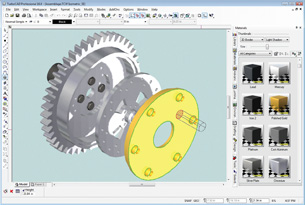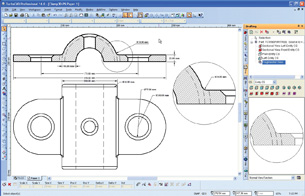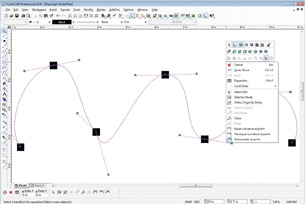Latest News
December 4, 2001
By David Cohn
 With the new QuickPull tool, you can hover over a face or region on a face and then push or pull it to offset, extrude, or imprint. You can even specify draft angle and add a chamfer or fillet. |
TurboCAD Pro 16 is the fourth major revision of TurboCAD since an investor-led group purchased International Microcomputer Software, Inc.’s (IMSI) precision drawing group and was renamed IMSI/Design LLC.TurboCAD. It turns out Version 16 might be one of the biggest upgrades in years.
TurboCAD Pro includes a huge selection of 2D drafting and 3D modeling functions, many based on industry-standard tools found in higher-end products. For example, the solids modeling capabilities are powered by V18 of the ACIS engine, LightWorks Rendering V7.9 from Lightwork Design enables the photorealistic rendering, and the geometric and dimensional constraints engine comes from D-Cubed.
It now includes the ability to create 2D sections based on 3D models, a new xref manager, improvements to dimensioning and Bezier curves, a new 3D quick pull function, a helix command, and new database capabilities. There are also big improvements in rendering, improved Google SketchUp import, and the ability to export to a SketchUp SKP file.
UI Showing Its Age
Long-time users may be pleased that the TurboCAD interface remains largely unchanged, with toolbars along the top and left edge of the screen, status and inspector bars along the bottom, and a palette area on the right. But with many applications adopting the Microsoft Office ribbon bar-type interface, TurboCAD’s UI looks more and more dated. Rather than simplifying that interface, TurboCAD’s developers keep adding things; there are now nearly 70 toolbars. You can also create tabbed toolbars and popup toolbars that appear when you open the local menu, modify a toolbar’s icons, and create your own toolbars.
There are also numerous ways of activating the same command: a button on a toolbar, a button on a flyout menu, a tool on one of the 19 palettes, a pull-down menu, or in some cases by typing a keyboard shortcut. And rather than having a single command with multiple options, TurboCAD retains its model of using a different command for each drawing option. For example, there are 13 different ways to draw an arc; you must choose the desired method when you first start the command. It can all be quite overwhelming for a neophyte or casual user.
Improved Drafting and Detailing
A new XREF Manager, built into the Block palette, enables users to manage external references much more efficiently. Xrefs can also now be exported with DWG or DXF files for greater AutoCAD file compatibility. Improvements to the Drafting palette make it easier to create standard 2D views that remain associative to 3D objects. You can even create nested, associative sections. If the model is changed or the section plane is updated, the 2D profiles are updated automatically.
TurboCAD Pro 16 has also added new options for editing Bezier curves. Equal curvature at point keeps the curve equal and smooth at the control point. Nonequal curvature at point keeps the curve smooth but lets you apply different curvature on either side of the point. And nonsmooth at point allows each side to be changed without affecting the other side.
 TurboCAD 16’s enhanced Drafting palette creates associative sections of surface and solid models and automatically scales dimension values to account for different scale factors used in the sections and fragmented views. The fragmented view will update automatically as the circle on the section moves. |
TurboCAD Pro is one of the few general-purpose CAD programs with constraint capabilities. You can create geometric constraints, such as parallel, perpendicular, tangent, and equal that constrains selected geometry. As you add constraints, TurboCAD adds small markers adjacent to the constrained geometry, with user control of whether markers are placed on their own layer or that of the constrained object as well as the printing of those markers. You can also apply dimensional constraints that control the size of objects that appear both as dimensions within the drawing and as a variable name and value in TurboCAD’s calculator palette. You can then include formulas in the calculator palette to establish mathematical relationships between variables. If the program’s Auto Add Constraints function is enabled, dimensions added using standard dimensioning commands automatically become dimensional constraints. We noted that in previous versions, once you had established a dimensional constraint, you could only change its value from within the calculator palette. But beginning in TurboCAD Pro 15, you can now also drag the dimension’s control points or even change its value in the Properties dialog.
TurboCAD 15 also added the ability to place angular dimensions on arcs and to show linear and angular dimensions using surveyor formatting. New in V16 is the ability to create custom arrow blocks and to match dimension scaling in paper space to that in model space, features that have long been available in AutoCAD.
Great New 3D Tools
TurboCAD’s 3D capabilities have always been extensive for a basic CAD program, growing more powerful with each release. TurboCAD Pro 15 introduced automatic workplanes by face. When enabled, the facet of a 3D object highlights in red when the cursor passes over it and any object you draw will be placed on that facet, similar to the dynamic UCS feature in AutoCAD. New in V16 is a QuickPull tool that lets you offset the face of an object or extrude or imprint a region on its face. You can even specify draft angle and add a chamfer or fillet to the geometry being modified.
As in previous versions, you can create 3D objects as standard objects such as boxes, spheres, cones, cylinders, and so on; by performing functions such as extruding, sweeping, revolving, and lofting 2D profiles; and by assigning a thickness to 2D objects. New in this release is an offset property that allows for the creation of a body with constant thickness. Also new is an ACIS-based Helix tool that can be used to create a 3D helical spline or a 2D spiral by specifying the starting and ending radius, the number of turns, and the height of each turn.
Although not really new (they were added in V15), two new assembly tools also deserve mention. Assemble by Tangents changes the position of an object by aligning a cylindrical face tangent to another cylindrical or flat face. Assemble by Axis changes the position of an object by aligning axes. Both are welcome additions, but do require some effort. For example, before you can use the Assemble by Axis command, you must first use the Set Assembly Axis command to establish the two axes to be aligned, which requires a total of six clicks.
Rendering and Interoperability Improved
Significant rendering enhancements result from the inclusion of v7.9 of the LightWorks Rendering engine, including the ability to save an unlimited number of rendering styles. TurboCAD Pro 16 comes with numerous predefined styles, and controls include the ability to simulate weather conditions, lens flare, ambient occlusion, and depth of field as well other artistic effects. Also new is the ability to simply drag and drop materials from the Material palette onto individual faces of a 3D object. Material scaling has also been improved, making it easier to preview changes on the fly.
TurboCAD Pro 15 added new bill of materials and parts list capabilities as well as the ability to create tables or import tables from AutoCAD DWG or DXF files. TurboCAD Pro 16 adds the ability to connect to a database and associate data with objects in the drawing or a TurboCAD table. A new Database Connection palette provides the tools to create and manage database connections to most ODBC and OLE databases. While quite powerful, setting up and managing database links appears to be a relatively complex procedure best left to those experienced with the various database protocols.
Compatibility with AutoCAD DWG and DXF files remains one of TurboCAD’s strengths, but we were unable to open files saved in the latest AutoCAD 2010 drawing format. TurboCAD’s SketchUp (SKP) file import filter has been enhanced to include version 7 files.
 New options for editing Bezier curves, available in a right-click menu, let you keep curves equal and smooth at a point, smooth but unequal at point, or enable you to change the curve on either side of a node independently. |
Units settings, dimension objects, construction lines, and camera properties are all now imported. In addition, you can export TurboCAD models to native SketchUp SKP files.
New Pricing, New Products
Starting with the previous release, IMSI/Design raised the price of its software significantly. TurboCAD Pro, the version we reviewed, now sells for $1,295. A lower-cost version, TurboCAD Deluxe, is just $129 but lacks many significant features, such as the new automatic workplane by face, lofting, BOM, and parametric part creation. But even the Pro version is no longer the top of the line. IMSI/Design now sells separate Architectural and Mechanical editions of TurboCAD Pro ($1,395 each) that add specific features tailored for those disciplines. For example, the Mechanical Edition includes tools for bending and unbending sheet metal and tubes, a flange tool, several parametric hole tools, and pattern constraints. The Architectural Edition includes parametric slabs, a style manager for architectural objects, more advanced stairs, additional parametric doors and windows, and an edit profile tool. You can even purchase a Platinum Edition ($1,495) that includes all of the tools from both vertical editions.
And then there are add-ons and plug-ins, such as AnimationLab ($199.95) for adding animation capabilities and a CAM plug-in ($299.95) for adding 2-1/2D machining capabilities. Users who buy TurboCAD Pro and then decide that they want the additional mechanical or architectural capabilities can purchase those as add-ons.
TurboCAD Pro is a very good CAD tool with some powerful modeling features. It’s also compatible with a wide range of other programs, including AutoCAD, MicroStation, FastCAD, SketchUp, and a host of others via SAT, IGES, STL, STEP, and other formats. But few users are likely to confuse TurboCAD Pro with higher-end modelers like Inventor or SolidWorks. Those programs offer much more elegant tools, and many more capabilities, but at a significantly higher price. Still, TurboCAD Pro has a lot to offer as a less-expensive alternative to market-leader, AutoCAD, and, with practice you could model some pretty sophisticated parts for a lot less.
More Info:
IMSI/Design LLC
Novato, CA
TurboCAD Pro 16
>Price: $1,295
>System Requirements: Pentium IV processor, Windows XP (512MB RAM) or Windows Vista (2GB RAM), 300MB free disk space plus 64MB minimum swap space, 1024x768 resolution display, CD-ROM.
Contributing Editor David Cohn is a computer consultant and technical writer based in Bellingham, WA, and has been benchmarking PCs since 1984. He’s the former editor-in-chief of Engineering Automation Report and CADCAMNet, and the author of more than a dozen books. Please send comments about this article to [email protected]. You can also contact David at [email protected].
Subscribe to our FREE magazine, FREE email newsletters or both!
Latest News
About the Author
David Cohn is a consultant and technical writer based in Bellingham, WA, and has been benchmarking PCs since 1984. He is a Contributing Editor to Digital Engineering, the former senior content manager at 4D Technologies, and the author of more than a dozen books. Email at [email protected] or visit his website at www.dscohn.com.
Follow DE





